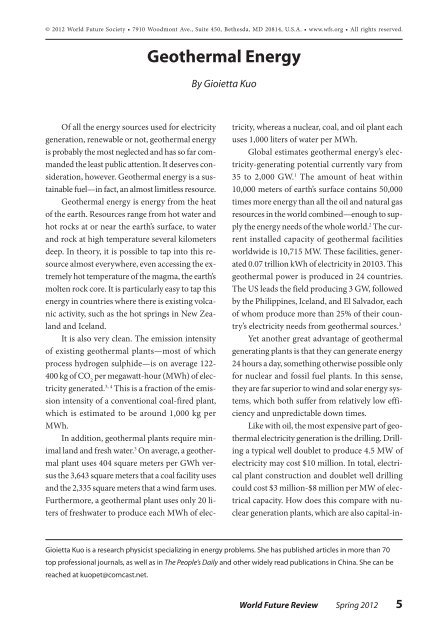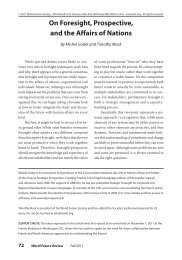Geothermal Energy - World Future Society
Geothermal Energy - World Future Society
Geothermal Energy - World Future Society
Create successful ePaper yourself
Turn your PDF publications into a flip-book with our unique Google optimized e-Paper software.
© 2012 <strong>World</strong> <strong>Future</strong> <strong>Society</strong> • 7910 Woodmont Ave., Suite 450, Bethesda, MD 20814, U.S.A. • www.wfs.org • All rights reserved.<br />
<strong>Geothermal</strong> <strong>Energy</strong><br />
By Gioietta Kuo<br />
Of all the energy sources used for electricity<br />
generation, renewable or not, geothermal energy<br />
is probably the most neglected and has so far commanded<br />
the least public attention. It deserves consideration,<br />
however. <strong>Geothermal</strong> energy is a sustainable<br />
fuel—in fact, an almost limitless resource.<br />
<strong>Geothermal</strong> energy is energy from the heat<br />
of the earth. Resources range from hot water and<br />
hot rocks at or near the earth’s surface, to water<br />
and rock at high temperature several kilometers<br />
deep. In theory, it is possible to tap into this resource<br />
almost everywhere, even accessing the extremely<br />
hot temperature of the magma, the earth’s<br />
molten rock core. It is particularly easy to tap this<br />
energy in countries where there is existing volcanic<br />
activity, such as the hot springs in New Zealand<br />
and Iceland.<br />
It is also very clean. The emission intensity<br />
of existing geothermal plants—most of which<br />
process hydrogen sulphide—is on average 122-<br />
400 kg of CO 2<br />
per megawatt-hour (MWh) of electricity<br />
generated. 3, 4 This is a fraction of the emission<br />
intensity of a conventional coal-fired plant,<br />
which is estimated to be around 1,000 kg per<br />
MWh.<br />
In addition, geothermal plants require minimal<br />
land and fresh water. 3 On average, a geothermal<br />
plant uses 404 square meters per GWh versus<br />
the 3,643 square meters that a coal facility uses<br />
and the 2,335 square meters that a wind farm uses.<br />
Furthermore, a geothermal plant uses only 20 liters<br />
of freshwater to produce each MWh of elec-<br />
tricity, whereas a nuclear, coal, and oil plant each<br />
uses 1,000 liters of water per MWh.<br />
Global estimates geothermal energy’s electricity-generating<br />
potential currently vary from<br />
35 to 2,000 GW. 1 The amount of heat within<br />
10,000 meters of earth’s surface contains 50,000<br />
times more energy than all the oil and natural gas<br />
resources in the world combined—enough to supply<br />
the energy needs of the whole world. 2 The current<br />
installed capacity of geothermal facilities<br />
worldwide is 10,715 MW. These facilities, generated<br />
0.07 trillion kWh of electricity in 20103. This<br />
geothermal power is produced in 24 countries.<br />
The US leads the field producing 3 GW, followed<br />
by the Philippines, Iceland, and El Salvador, each<br />
of whom produce more than 25% of their country’s<br />
electricity needs from geothermal sources. 3<br />
Yet another great advantage of geothermal<br />
generating plants is that they can generate energy<br />
24 hours a day, something otherwise possible only<br />
for nuclear and fossil fuel plants. In this sense,<br />
they are far superior to wind and solar energy systems,<br />
which both suffer from relatively low efficiency<br />
and unpredictable down times.<br />
Like with oil, the most expensive part of geothermal<br />
electricity generation is the drilling. Drilling<br />
a typical well doublet to produce 4.5 MW of<br />
electricity may cost $10 million. In total, electrical<br />
plant construction and doublet well drilling<br />
could cost $3 million-$8 million per MW of electrical<br />
capacity. How does this compare with nuclear<br />
generation plants, which are also capital-in-<br />
Gioietta Kuo is a research physicist specializing in energy problems. She has published articles in more than 70<br />
top professional journals, as well as in The People’s Daily and other widely read publications in China. She can be<br />
reached at kuopet@comcast.net.<br />
<strong>World</strong> <strong>Future</strong> Review Spring 2012 5
tensive but cost relatively little to run A standard<br />
nuclear reactor could have a capital cost of $3 billion<br />
for a 1000 MW plant, while an enhanced geothermal<br />
system (EGS) may have a capital cost of<br />
$4 million per MW.<br />
As for running costs, most of the energy costs<br />
for coal, gas, and renewables are in the range of<br />
$0.03-0.09/kWh 4 with nuclear energy toward the<br />
low end of the scale and wind and solar costing<br />
out at the high end. <strong>Geothermal</strong> EGS have an average<br />
cost of about $0.06 per kWh. However, geothermal<br />
power has the advantage that it is very<br />
scalable. A small plant might cost-effectively supply<br />
all the electricity needed to power a rural village,<br />
while nuclear and coal generation plants are<br />
only economical in larger-scale facilities producing<br />
1,000 MW or more.<br />
A development which has great potential is<br />
the direct use of the heat from<br />
shallow ground two or more<br />
meters deep which the earth<br />
maintains at a constant temperature<br />
of about 10-16° C. 5 A<br />
geothermal heat pump can tap<br />
into this resource to heat and<br />
cool buildings. The system<br />
consists of heat pump, an air<br />
delivery system (ductwork),<br />
and a heat exchanger—a system<br />
of pipes buried in the shallow<br />
ground near the building.<br />
In the winter, the heat pump<br />
removes heat from the heat exchanger<br />
and pumps it into the<br />
indoor air-delivery system. In<br />
the summer, the process is reversed: The heat<br />
pump moves heat from the indoor air into the<br />
heat exchanger.<br />
The heat removed from the indoor air can<br />
also be used to provide a free source of hot water.<br />
There are many other possible uses for this direct<br />
gentle heat, such as for greenhouses, drying crops,<br />
warming the pond water in fish farms, and in in-<br />
Figure 1. Dry Steam<br />
Power Plant<br />
Generator<br />
Turbine<br />
Ground Surface<br />
Wellhead<br />
dustrial processes such as pasteurizing milk. Since<br />
these direct heat applications can use much shallower<br />
wells and operate at lower temperatures,<br />
smaller systems with lower costs and risks are feasible.<br />
Residential geothermal heat pumps with a<br />
capacity of 10 kW are routinely installed for<br />
around $1,000-$3,000 per kW. 6 There are three<br />
basic type of geothermal power station for electricity<br />
generation depending on the depth of the<br />
well and temperature of the steam used for driving<br />
the turbines.<br />
1. Dry Steam Power Plant<br />
This is the most direct plant using steam of<br />
150° C to turn turbines. Figure 1 shows a simple<br />
system. The pipe carries cold water, which is<br />
pumped into the ground, where it is heated by<br />
running through hot rock (which has sometimes<br />
been cracked by explosives or<br />
Condenser<br />
Wellhead<br />
Explanation<br />
Water<br />
Steam<br />
Subsurface<br />
Injection<br />
highly pressurized water to facilitate<br />
the release of heat). It<br />
converts to steam and is<br />
pumped back up to the surface<br />
to drive a steam turbine. A<br />
condenser then produces water,<br />
which is returned to the<br />
ground.<br />
2. Flash Steam Power Plant<br />
Water inside a well is<br />
heated to temperatures greater<br />
than 180° C and then pumped<br />
via high pressure to generation<br />
equipment at the surface. Once<br />
the hot water reaches the generation<br />
equipment, pressure suddenly decreases,<br />
which allows some of the hot water to flash-convert<br />
to steam. This steam is then powers the turbine/generator<br />
to produce electricity. The remaining<br />
hot water is condensed from the steam and<br />
pumped back into the reservoir. The largest geothermal<br />
system in operation today is a steam<br />
driven plant located in Geysers, California.<br />
6 <strong>World</strong> <strong>Future</strong> Review Spring 2012
3. Binary Cycle Power Plant<br />
This is a recent development that can operate<br />
using fluids at temperatures as low as 58° C.<br />
It works by passing moderately hot water through<br />
a heat exchanger with a fluid that has a much<br />
lower boiling point than water. This secondary<br />
fluid flash vaporizes, which in turn drives the turbine.<br />
This is the most common type of geothermal<br />
electricity generating plant being constructed<br />
today, chiefly because it relies on relatively low<br />
temperature and requires a shallower well. Hence<br />
it has the widest potential for development.<br />
Status of <strong>Geothermal</strong> <strong>Energy</strong> <strong>World</strong>wide<br />
A new system now under development, called<br />
Enhanced <strong>Geothermal</strong> Systems (EGS), aims to capture<br />
the heat in “hot dry rock.” The hot rock reservoirs,<br />
typically situated 4-10 kilometers below the<br />
surface, are first broken up by high-pressure water<br />
that is pumped through them. The plants then pump<br />
cold water through the broken hot rocks. The cold<br />
water heats up, turns into steam, and returns to the<br />
surface, where it powers turbines. This resource has<br />
enormous potential and can be used on a much<br />
larger scale than other geothermal methods.<br />
At present, two emerging technologies are attempting<br />
to tap into the full potential of geothermal<br />
energy. EGS is one of these. The other is coproduction<br />
of geothermal electricity in oil and gas<br />
wells. Although this latter technology still needs<br />
further development, it offers a huge advantage in<br />
that the wells themselves already exist, so there is<br />
no need for capital-intensive additional drilling.<br />
Considering that geothermal energy offers<br />
practically limitless resources, why is it that the<br />
existing world production is only around 0.07 trillion<br />
kWh, or roughly 0.3% of global energy production<br />
The main reason is the high cost of drilling<br />
geothermal wells. As we know, drilling for oil<br />
has been going on for over a century, and the process<br />
has developed gradually with time. Like nuclear<br />
reactors, a typical geothermal plant requires<br />
a long lead time, taking 5-10 years to develop.<br />
Yet the advantages of geothermal energy are<br />
numerous. It is worthwhile to summarize them<br />
briefly below:<br />
• It is a limitless energy resource with no fuel<br />
costs.<br />
• As an energy baseload, it is capable of producing<br />
electricity 24 hours/day.<br />
• It produces only a small fraction of the toxic<br />
gas emissions that coal produces.<br />
• It uses a mere 12% of the land per GWh produced<br />
as coal facilities.<br />
• It uses only 20% of the water per MWh required<br />
by nuclear, coal or oil powered plants.<br />
• It is very scalable, a small plant can easily be built<br />
to supply a rural village at relatively low capital cost.<br />
• <strong>Geothermal</strong> heat is obtainable almost<br />
everywhere on earth.<br />
• Exploiting the co-generation from existing<br />
oil wells would greatly reduce drilling costs.<br />
• Heat from shallow ground has multiple industrial<br />
uses that include heating greenhouses,<br />
fish farms, pasteurizing milk, etc.<br />
• Capital cost, though high, is comparable to<br />
that required to build other energy facilities.<br />
How does geothermal energy compare with<br />
other renewable sources like wind, solar, or biofuels<br />
As noted above, geothermal offers many distinct<br />
advantages, and development costs are similar.<br />
In sum, the potential for geothermal energy is<br />
great, and it is high time we paid more attention to<br />
developing this neglected energy resource.<br />
References<br />
1. http://iga.cnr.it/documenti/IGA/Fridleifsson_et_al_<br />
IPCC_<strong>Geothermal</strong>_paper_ 2008.pdf<br />
2. http://www.uxsusa.org/clean_energy<br />
3. http://en.wikipedia.org/wiki/<strong>Geothermal</strong>_electricity<br />
4. http://www.renewableenergyworld.com/rea/tech/<br />
geothermal-energy<br />
5. Knapp and Kuo, “The <strong>Future</strong> of Nuclear <strong>Energy</strong>,”<br />
Innovation and Creativity in a Complex <strong>World</strong>, <strong>World</strong><br />
<strong>Future</strong> <strong>Society</strong>, 2009<br />
6. http://en.wikipedia.org/wiki/<strong>Geothermal</strong>_energy<br />
<strong>World</strong> <strong>Future</strong> Review Spring 2012 7
















